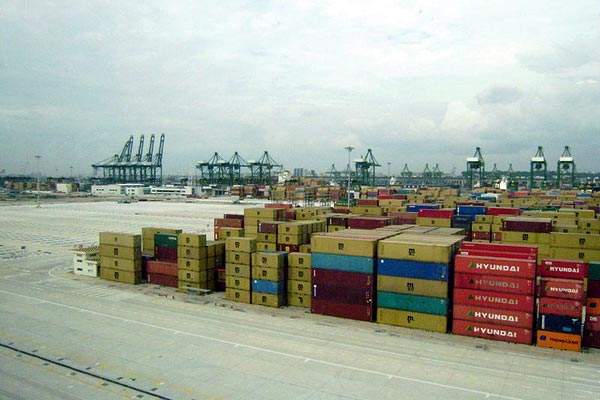The Port of Singapore is the busiest container transhipment hub and the largest publicly owned port in the world. Located on the southern end of the Malay Peninsula, 30km south-west of the Port of Johor in Malaysia, the Port of Singapore offers connectivity to more than 600 ports in 123 countries.
The Maritime and Port Authority of Singapore (MPA) owns and is responsible for the growth and development of the port.
The port handled 37.2 million twenty-foot equivalent units (TEUs) of containers and 626.2 million tonnes of cargo in 2019. It attracts approximately 130,000 vessel calls a year, on an average, currently.
The port underwent S$3.5bn project at the Pasir Panjang terminal to add 15 mega containership berths, which was completed in June 2015. The terminal is capable of handling container vessels of 130,000TEUs or more.
Tuas Port – an automated container terminal at Port of Singapore
“Tuas port is expected to be the world’s biggest fully-automated terminal when completed.”
A large automated container terminal, named Tuas Port, is currently being built at the port, which will have the capacity to handle 65 million TEUs upon completion in 2040. Tuas port is expected to be the world’s biggest fully-automated terminal when completed.
Tuas port will incorporate innovative technologies such as yard automation and full-electric automated guided vehicles.
All the existing Singaporean container terminals will be merged and relocated with the Tuas terminal, upon its completion.
Critical functions
The port offers a range of services for break bulk and specialised cargoes. The facilities and services allow the port to handle containers and cargo including bulk, break-bulk and project cargo.
The warehouses and open yard spaces are used for storage, packing, consolidation and distribution of cargo. Approximately 80% of the containers that arrive in Singapore are transhipped to other ports.
The Port of Singapore has conventional and special-purpose terminals to handle oil, petroleum and natural gas products as well as cement and steel products. It also has a dedicated car terminal, which is one of the major automotive transhipment hubs in the region.
Other ancillary services include the supply of water and provisions. Pilotage and towage services are also provided.
Facilities at Port of Singapore
The facilities at the Port of Singapore include container terminals, berths, cranes, storage facilities, port information systems, an approach channel and an inter-modal transport system.
The Port of Singapore has terminals at Brani, Keppel, Tanjong Pagar, Pasir Panjang, Jurong and Sembawang. The terminals can handle coasters and lighters, cargo freighters, RO-RO ships, bulk carriers and container vessels. Brani, Keppel and Tanjong Pagar are planned to be moved to Tuas Port by 2027, followed by Pasir Panjang terminals by 2040.
The anchorage areas in the port include the Eastern Sector, the Jurong Sector and the Western Sector. The public landing areas, West Coast Pier, Marina South Pier and Changi Point Ferry Terminal, have dining outlets, shops, immigration and ferry services.
Port of Singapore terminal operators
PSA International operates the major terminals in the port through its flagship terminal PSA Singapore Terminals. The four container terminals, Brani, Keppel, Tanjong Pagar, Pasir Panjang, and a multi-purpose terminal, Sembawang, are solely operated by PSA Singapore Terminals.
One terminal, Jurong, is operated by Jurong Port that handles steel, cement, copper slag and project cargo mostly. The Maritime Port Authority of Singapore looks after the regulatory functions.
Security
The Terminals Security Department maintains high levels of security in co-operation with the Maritime and Port Authority of Singapore, the Police Coast Guard, the Republic of Singapore Navy and the Singapore Civil Defence Force. The ports security features include an armed auxiliary police force, perimeter fencing, manned gates, 24h CCTV surveillance system and metal detectors for people and cargo.
The port complies with International Ship and Port Facility Security (ISPS) Code in order to improve the security of ships and the port facilities.
The police force conducts regular patrols and checks to control threats from external sources. Other security procedures include security pass system for staff, temporary passes for visitors, and an IT system to track movement/location of all containers within the terminal.
Equipment
The port is equipped with 204 quay cranes and number of gantry cranes that can handle larger ships such as UASC A7-Class vessels. Each operator can handle six cranes with the help of remote-controlled bridge cranes.
The quay cranes have twin-lift capability and can outreach across 22 rows of containers. The port also operates mobile harbour cranes to handle heavy-lift project cargo.
Maintenance services
The port has dedicated anchorages for ship repairs and maintenance operations. The services offered are ship repair and maintenance, monitoring of temperature for refrigerated containers and container repair and maintenance including the supply of spare parts and services. The other services include container survey and washing.








